On Aug. 17, 2022, the Freshwater Collaborative Steering Committee will participate in a strategic conversation at UW-La Crosse from 9 a.m.- 4 p.m.
Agenda coming soon
On Aug. 17, 2022, the Freshwater Collaborative Steering Committee will participate in a strategic conversation at UW-La Crosse from 9 a.m.- 4 p.m.
Agenda coming soon
Watch the video created by the UW-Eau Claire communication team.
Nine undergraduates from UW-Eau Claire and UW-River Falls spent an intensive two weeks in June exploring and conducting research in rivers, watershed and creeks through enrollment in a new Western Wisconsin Advanced Freshwater Science field course.
Funded by the Freshwater Collaborative of Wisconsin, the hands-on field course is a collaboration among UW-Eau Claire, UW-River Falls, UW-Stout and UW Oshkosh that brought together instructors with expertise in geology, biology, environmental science, geography and agricultural science to provide a unique opportunity for students majoring in degrees related to freshwater science. The students involved included biology, ecology, environmental geography and environmental science majors.
The goal was to create a field experience involving skills and tools used across a variety of freshwater science disciplines. Maggie Guetschow, environmental geography major at UW-Eau Claire, appreciated the multidisciplinary approach.
“You’re going to have to have collaboration between fields in order to solve these really complex issues that we’re looking at with our environment,” she says. “It’s very important and incredible to have a course like this that you can have so many people with so many different pieces of expertise that they’re able to give us and give us background in their different areas of study.”
Sarah Vitale, an assistant professor at UW-Eau Claire and the lead instructor, says this type of course didn’t previously exist within a traditional degree curriculum.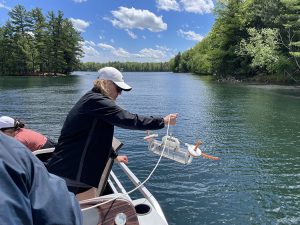
“There are always limitations to what an individual department or institution can offer, and the Freshwater Collaborative of Wisconsin is breaking those barriers, allowing us to build something beneficial for students and faculty in the UW system,” Vitale says.
Vitale says the instructors were impressed with the level of student engagement and positive attitudes — even when it was pouring rain and cold. Students participated in a diverse number of field experiences during the eight-day course, including:
Not only did students benefit from the range of experiences and the multidisciplinary approach, but they gained perspective about their future career options.
“It really helps me get a feel for what kinds of opportunities I can have when I graduate, and also it helps me figure out what I like to do and what I don’t like to do,” says Sydney Schermerhorn, an ecology and environmental biology major at UW-Eau Claire. “That’s also really helpful in finding a career path that I want to go into.”
As the school year cooled down, Freshwater Camp at UW-Parkside and UW-Whitewater was heating up. High school juniors and seniors from Wisconsin and northern Illinois took part in a week-long exploration of freshwater careers while enjoying recreational opportunities that Wisconsin’s waterways provide.
“Freshwater Camp provided the opportunity for students to visit a variety of freshwater habitats, gain hands-on experience paddling, use a variety of equipment to sample aquatic macroinvertebrates, fish and water quality parameters, and to meet with professionals who work in water-related careers,” says Elisabeth Harrahy, an associate professor at UW-Whitewater who designed the course with Jessica Orlofske, an associate professor at UW-Parkside.
Many students in southeastern Wisconsin high schools, particularly those from underserved communities, aren’t aware of the vast array of options available to them to study and to obtain a career in a water-related field. One of the camp’s goals was to raise awareness and provide access to students who may not have the means to participate in this kind of experience. Funding from the Freshwater Collaborative of Wisconsin gave 18 high school students the opportunity to attend the camp and provided free dormitory housing, meals and transportation throughout their stay.
After dropping off their gear in the UW-Parkside dorms Monday morning, the students headed for the Root River Environmental Education Community Center for kayaking and water testing. After lunch, the campers learned about water quality testing before heading back to campus.
“This was my first time kayaking and I really enjoyed that. I am excited to be able to learn in an outdoors environment,” says Adam Turner, a student from Whitefish Bay High School, who echoed the sentiments of many of his fellow campers.
While some of the students came to the camp for a bit of fun, other campers like Hayley Tench from Harborside Academy in Kenosha attended the camp with specific reasons in mind.

“I wanted to come to Freshwater Camp because I want to go into environmental conservation, and I believe a background in wildlife and fisheries would be a good thing to have and I thought it would be a fun thing to do for the summer,” she says. Hayley’s future plans fit perfectly with the objectives of the free camp.
Day two included fish and invertebrate sampling on the Pike River in the morning, which was of particular interest to Numa Khan, a recent graduate of Warren Township High School.
“I attended the camp because I thought it would be fun and I already took an environmental science course and enjoyed it, so I wanted to continue learning about it. I am most excited to learn more about fish and invertebrates,” she says. For Hayley, it was learning about electrofishing that is used to capture fish for sampling and doing counts.
In the afternoon, it was off to the lab to learn about macroinvertebrates with camp directors Orlofske and Harrahy. Students also learned about water chemistry.
“Throughout the camp, students became comfortable working in waders, learned to identify several types of aquatic invertebrates used for routine regulatory monitoring; performed basic water analysis; and discussed the importance of experimental controls, randomization and protocol standardization,” Orlofske says. “Many of these skills apply to all areas and fields of science, but are especially important for studies of our freshwater ecosystems.”
On Wednesday, the campers toured Samuel Myers Park and North Beach Park in Racine before heading to UW-Whitewater for the second half of the camp.
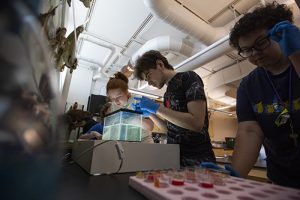
Thursday morning found the Freshwater Camp students setting up an aquatic toxicity test to determine the effects of caffeine on survival of water fleas. They then visited Whitewater Lake in the Kettle Moraine State Forest where they discussed the importance of shoreland restoration, collected phytoplankton and zooplankton samples using Kemmerer samplers and plankton nets, and measured water quality parameters using test strips, meters and a Secchi disk.
In the afternoon, they visited Bluff Creek State Natural Area where they collected aquatic macroinvertebrates using nets and a Hess sampler, measured current velocity and various water quality parameters, and learned how to apply the Citizen Monitoring Biotic Index to assess the health of the stream. After dinner, they played video games, air hockey and table tennis or bowled at Warhawk Alley in the UW-Whitewater Student Center.
On Friday, the students visited Beulah Bog State Natural Area where they hiked into the bog, learned about this unique type of wetland, and observed three different types of carnivorous plants. In the afternoon, they spent some time in the laboratory breaking down their toxicity test and examining their plankton and macroinvertebrate samples before heading home.
“We hope to have opened these students’ eyes to the importance of protecting our many water resources, the possibility of pursuing a career in a water-related field and what the UW system campuses have to offer in these areas,” Harrahy says. “Above all, we hope the students had a great time and enjoyed interacting with each other.”
This article was co-written by Laura Mason, UW-Parkside, and Heidi Jeter, Freshwater Collaborative of Wisconsin.
As a first-year science teacher at Aldo Leopold Community School in Green Bay, Wis., Mark Valentine was looking for experts to help him teach lessons about our environment and ecosystems. He found the perfect way to fulfill this goal: growing wild rice in the classroom.
Valentine was one of 17 teachers and more than 400 students from 14 schools who participated in the University of Wisconsin–Green Bay’s Wild Rice in the Classroom program during the 2021-2022 school year. The program engages local teachers and K-12 students in conservation efforts that enhance native wetland plant communities in the Bay of Green Bay coastal wetlands and beyond.

Teachers are given all the materials — lights, buckets, growing medium and wild rice seed — to successfully grow the rice. They also learn about the historical, cultural and ecological importance of Manoomin (wild rice in Ojibwe).
“The students and I learned so much about the importance of wild rice for indigenous people and the ecosystem where it grows,” Valentine says. “It felt extra special to be a part of the process of helping to restore this plant to the watershed.”
In May 2022, UW-Green Bay staff and students hosted a series of field trips to L.H. Barkhausen Waterfowl Preserve in Suamico, Wis., where teachers and more than 100 students transplanted their plants as part of a wetland restoration effort. In addition, students learned about freshwater turtles and met a painted turtle education ambassador, participated in a nature walk, and engaged in an interactive activity with Atlas Science Center staff to simulate the environmental and economic impacts of invasive species.
“Students were able to actively participate in the growing and planting of a native species to combat a non-native. This activity gave them a sense of ownership of their environment and what they did does matter,” says Lynn Ponto, a teacher at Weyauwega-Fremont High School Science in Weyauwega, Wis. “Being able to plant under the guidance of professionals allowed them to feel the importance of protecting the diversity in our environment.”
Students also learned about diverse water science career experiences. Valentine says listening to UW-Green Bay students share their stories about pursuing degrees and careers in the natural resources inspired his students.
“Many of my science students dream of following similar paths in the future!” he says.
The field trips were supported by UW-Green Bay’s College of Science, Engineering and Technology, Atlas Science Center, Brown County Parks, and Ducks Unlimited, with funding from the U.S. Fish and Wildlife Service Coastal Program and NEW Water.
This year, the Freshwater Collaborative of Wisconsin provided funding to UW-Green Bay to expand the program and further develop an educator network that will link water-related research activities in the region; help teachers share curriculum, best practices, data and resources; and fuel continued engagement in water science and student career development.
These kinds of collaborations are important to Dave Landers, a sixth-grade science teacher at Pulaski Community Middle School in Pulaski, Wis., and Kelly Koller, technology integration specialist at Bay View Middle School in Green Bay. They facilitate an after-school program called Great Lakes Explorers, which connects students to the Great Lakes watershed. The wild rice program was a fantastic activity for the group.

“Students really enjoyed planting our wild rice at Barkhausen, learning more about the cultural and scientific significance of wild rice in our area and doing other ecosystem-related activities,” Koller says.
Landers says place-based experiences engage and empower students to better understand the ecosystem, gain a cultural perspective and then take action within their local watersheds. It could also prompt them to explore water-related careers.
“One of the highlights was surely putting on the rubber boots and getting their hands wet and feet dirty as they seeded and later planted the wild rice,” he says. “This experience is a great example of using the outdoor learning classroom to foster and engage students’ natural curiosity and wonder.”
The Freshwater Collaborative of Wisconsin supported 42 projects with $3.42 million of the $5 million in legislative dollars in March 2022 and will distribute another $800,000 in July 2022. This funding is creating impactful opportunities in research, student experiences, course development and career pathways. We continue to leverage the talents and resources across UW System to train the next generation of water professionals, address the 10 Grand Water Challenges and engage industry partners, community members, policymakers and advocacy groups.
We are addressing various water challenges across the state of Wisconsin. The following water challenges are most frequently addressed in projects and have been designated by the state legislators as major concerns for Wisconsin and its citizens:
Student Experience projects focus on recruitment and retention by engaging students in hands-on learning. These experiences include:
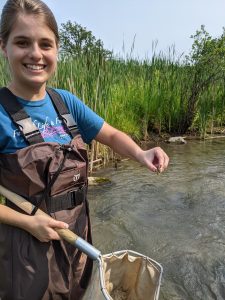
“My favorite part of the project was going into the streams. I learned I really like fish! Now I want to be on the science side doing the work.” —Faune Fisher, a May 2022 graduate from UW-Whitewater who is now working as a quality manager at Epic Systems in Verona, Wis.
Collaborative Research projects are tackling water challenges while training undergraduates in freshwater research techniques, protocols and problem solving. Research topics include:
“We provide opportunities for students to learn the techniques, the workflow and the environment of this type of laboratory. One of the goals of our Freshwater Collaborative project was to make inroads with other campuses and bring students from the different campuses together.” —Greg Kleinheinz, Viessmann Chair of Sustainable Technology, professor of environmental engineering technology and director of the Environmental Research and Center at UW-Oshkosh
Career Development projects focus on helping students enter the water sector. The Freshwater Collaborative is building a statewide internship program and will create a hub for students to apply to opportunities. Students present their research findings at Research in the Rotunda and other professional conferences and are introduced to water professionals in the private sector, governmental agencies and nonprofit organization, thereby expanding their professional networks.

“This program was very field heavy, and it taught me that conditions are variable and to be prepared to problem solve. This also helped me to notice what type of career I would like.”
—Britta Larson, a biology and chemistry major at UW-Superior, tested beaches for coliforms, E. coli, microcystin and microplastics in Door County; looked at parameters that could influence bacteria levels at the beaches; assisted in method development for finding and analyzing the microplastics; and analyzed the safety of drinking water.
Recent UW-Madison graduate Sara Pabich is spending her summer monitoring beach water quality and testing for E. coli and other harmful bacteria on Washington Island. She’s one of several summer employees of the Environmental Research and Innovation Center at University of Wisconsin Oshkosh whose work is supported through the Freshwater Collaborative of Wisconsin. Her work is part of a statewide water quality program. She’ll enter a graduate program in public heath and public policy at UW-Madison this fall.
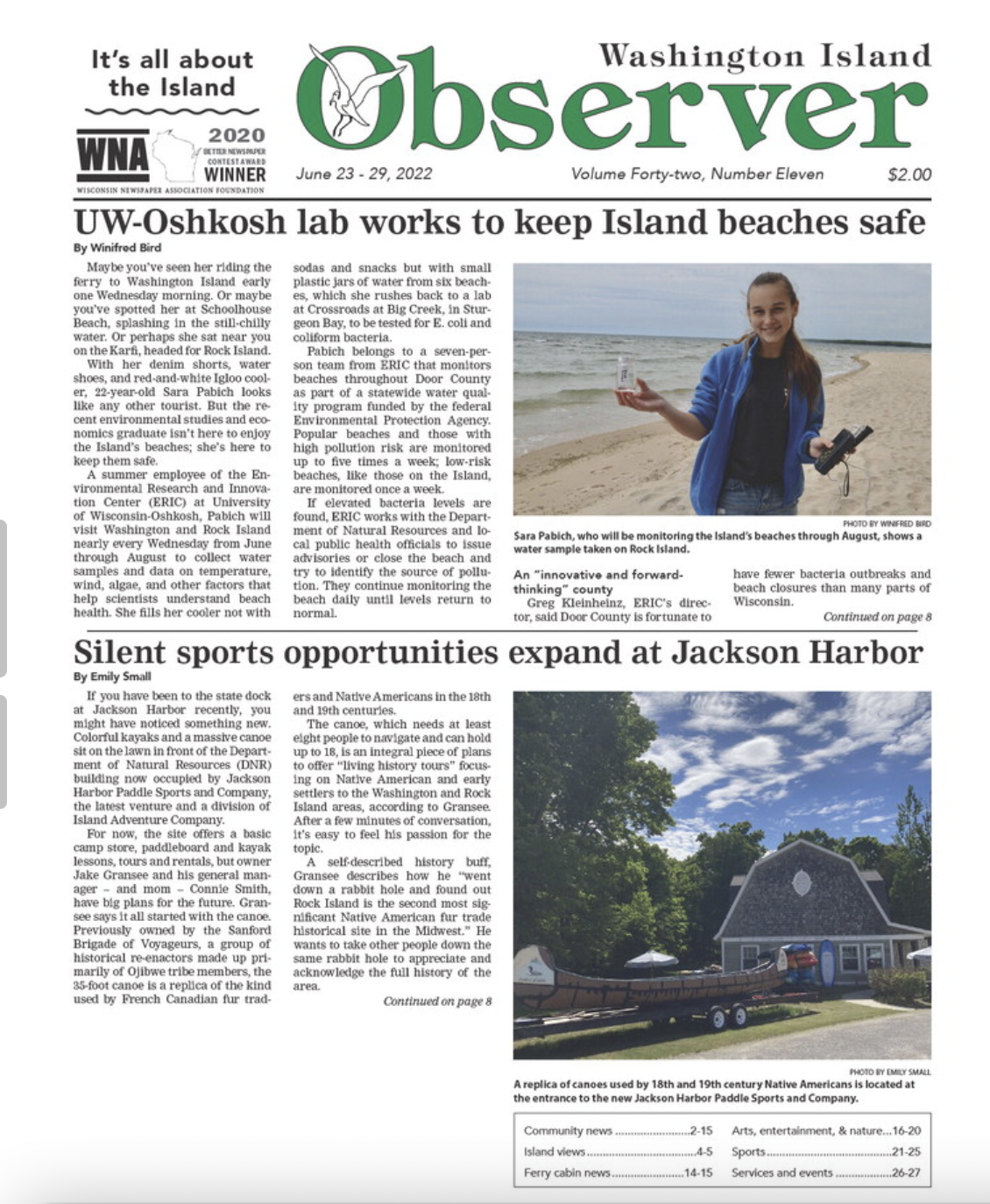
Laguna Bacalar, Mexico’s second largest natural lake, is one of the most unique freshwater lakes on Earth. Part of an important ecological corridor, ranging from tropical forest to the Caribbean Sea, it is also threatened by economic development.
Last spring, six students from the University of Wisconsin–Milwaukee and one from the University of Wisconsin–Whitewater found out what it was like to study this one-of-a-kind ecosystem. They participated in a freshwater field experience established by the UWM School of Freshwater Sciences with support from the National Science Foundation’s International Research Experience for Students (IRES) Program. (For information on the fall 2022 semester experience, click here).
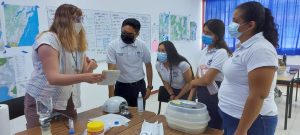
The students — undergraduate and graduate students enrolled in diverse degree programs — spent six weeks conducting collaborative field research in Bacalar. Research topics ranged from mangrove forest biometrics to water quality mapping map to submerged vegetation analysis and more. Their research was overseen by scientists from ECOSUR, a public scientific research center focused on sustainable development in Mexico, Central America and the Caribbean.
“I felt so incredibly lucky to have this experience and collaborate with such knowledgeable and experienced faculty and local agency leaders,” says Rachel Clark, an undergraduate student in the Environmental Engineering program at UWM. “I was able to practice my Spanish and be in a wonderful culture in an incredibly unique ecosystem.”
Faculty from UWM’s School of Freshwater Sciences have been conducting research in Bacalar for years and had developed connections with the CREN Normal College, a teaching college in Bacalar. The NSF support allowed them to establish the Laguna Bacalar International Research Station and what will be an ongoing semester abroad experience for students enrolled at higher education institutions in Wisconsin and beyond.
“We now have a nice classroom and lab space at the Normal College,” says Jerry Kaster, professor emeritus at the School of Freshwater Sciences and the principal investigator on the NSF grant.
Last March, Kaster, fellow emeritus professors Val Klump and Tim Grundl, and Marissa Jablonski, executive director for the Freshwater Collaborative, traveled to Bacalar to sign the official documents for the program, set up the lab and introduce the UW students to scientists and mentors in Bacalar.
“Conducting research in a unique ecosystem, like Bacalar, is an amazing hands-on learning experience for students,” Jablonski says. “We look forward to promoting this program to UW students through the Freshwater Collaborative of Wisconsin.”
Amaranta Ramos Sánchez, an English teacher at the Normal School, was instrumental in organizing interactions between the UW students who were conducting field research and students from the Normal School who are training to become teachers.
The UW students learned how to better explain their research, and the Normal School students were able to practice their English language knowledge. At the end of the semester, students were paired up to create final presentations for each research project.
“The event was a big success, and all the students felt satisfied and proud of their performance and achievements. The linguistic and cultural exchange between the students proved to be a unique experience,” says Ramos Sanchez, who hopes to brainstorm additional ways to integrate the students during the semester.
For Maddie Burclaw, a marine biology major at UW-Whitewater who is considering future conservation work with the Peace Corps or the United Nations, the scope of the academic and cultural exchange was invaluable.
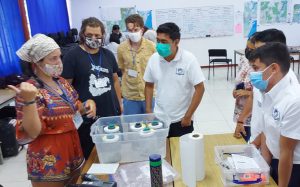
“I’ve learned skills such as how to use different types of lab equipment, how to communicate on a cross-cultural level, and how to use my skills as a scientist and a humanist in order to brainstorm action plans for sustainable development,” she says.
With the program up and running, students will be able to participate in this study abroad exchange each fall semester. Applications for fall 2022 are being accepted June 1 to August 26. For information on the fall 2022 semester experience, click here.
On June 29, 2022, the Freshwater Collaborative Steering Committee will participate in a strategic conversation at UW-Stevens Point.
Agenda:
8:45 AM Arrival
9:00 AM Introductions, brief background, and agenda
9:15 AM Clarify objectives
9:45 AM Assessing current state
· What is working?
· What opportunities for improvement exist?
11:00 AM Envisioning a future of successful collaborations
12:00 PM Lunch
12:45 PM Prioritizing opportunities
· Detailing possibilities
· Seeking common ground
3:00 PM Barriers to future success
3:45 PM Next steps & Wrap up
4:00 PM Adjourn